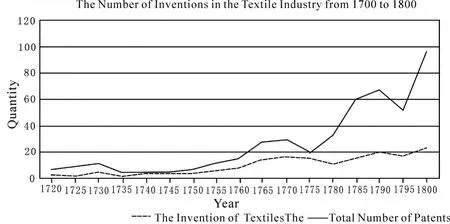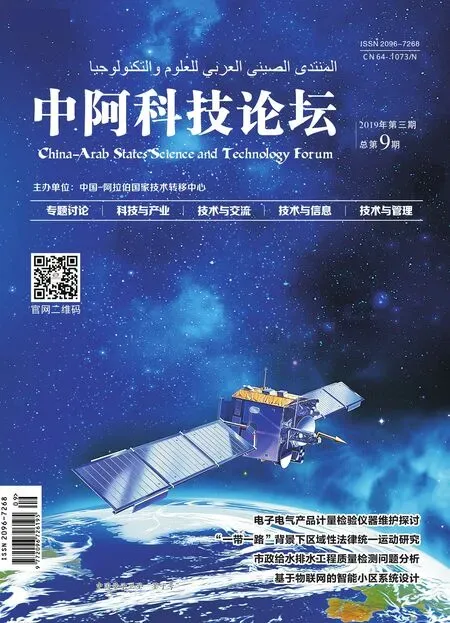Modern British Technology Patent System—from the Perspective of Textile Technology
Chang Yue,He Chaoan
(Faculty of Humanities,Donghua University,Shanghai 201620)
Abstract:Britain is one of the first countries in the world to use the technology patent system,the development of its patent system has gone through three major stages.In the first stage,the Britain royal family granted patents by issuing writs of formula in the 13th century,which was the prototype of the British patent system.In the second stage,the Britain issued England's Statute of Monopolies in the 16th and 17th centuries,which initially formed the modern British patent system.In the third stage,the Britain established the Patent Office and issued the Patent Law Amendment in the middle of the 19th century,which formally established the modern technology patent system.In recent centuries,the textile industry has always been the leading industry in Britain,which laid the foundation for the economic and technological development of Britain.The development of textile technology and the development of patent system complement each other.This paper explores the development of the modern British patent system through the development of the textile industry and textile technology in Britain.
Keywords:patent system;textile technology;the industrial revolution;technological innovation
I.Origins of the British Patent System
The British technology patent system was originated in the 12th century during the reign of King Henry III.A man in Bordeaux,England,discovered a production method of colored cloth,which greatly improved the efficiency of the process.And in 1236,King Henry III granted the citizen a 15-year monopoly on the manufacture of colored cloth[1],which was the prototype of the British technology patent system.
Britain is a big country of agriculture and sheep husbandry.The textile industry represented by wool accounts for a large proportion of the British economy.In 1300,the wool export accounted for 93%of the total export.By the 13th century,the textile industry in Britain had developed a huge monopoly trade association.The association excluded domestic and foreign textile technicians from engaging in textile work in the UK for its own interests,which greatly hindered the development of the textile industry and other handicraft industries in the UK,resulting in the textile technology strength and economic development speed in UK always lagging be-hind other countries around.In order to encourage the development of new technologies and break the monopoly of association,the British royal family began to issue writs of formula to technicians and craftsmen who brought new technologies at home and abroad[2].The writ of formula was known as“Letters Patent”at that time,from which the original English word Patent came.People with writs were privileged in designated trades and were not restricted by the British association,but they were required to teach these skills to British workers.
The earliest writ was issued by King Edward III to an English textile worker in 1331.In order to introduce advanced textile and dyeing technology,in 1364,the King of England issued a writ of formula to three foreign textile craftsmen,allowing them to engage in work related to the textile industry in Britain.This patent system stimulated the development of British textile industry,watch industry,salt and iron industry and other industries,and played a positive role in the rapid development of British science,technology and economic strength.During this period,a number of new and efficient textile tools were invented,promoted and applied,such as cardingmachine,spinningmachineand hydraulic bleaching machine,which promoted the rapid development of British textile industry.From 1470 to 1510,the annual growth rate of British textile exports reached more than 25%[3],and the textile products made in Britain almost monopolized the European market,creating a large amount of economic income for Britain.
II.The Initial Formation of British Technology Patent System
The British patent technology system was initially formed in the 16th century.During the reign of Queen Elizabeth,royal licensing of patents reached an unprecedented hot period.At this time,the enclosure movement was popular,and the wool production was greatly increased with the expansion of the pasture.The profits of the textile industry increased sharply,and the wool cloth products by the textile workers were sold overseas.In 1565,British wool textile products accounted for 79%of the total export volume[4],more and more people at home and abroad hope to get patent authorization to manage the textile business.The British royal family would charge a certain fee in exchange for the patent authorization,so the patent authorization became an important economic source for Britain,which alleviated the national financial crisis at that time.However,since the royal family had absolute patent licensing rights at that time,patent licensing was widely abused as a way to increase royal income.In order to increase the income,some products with no technical content were issued patent rights,and the royal family even granted the patent rights as a reward to the royal family and nobles and royal ministers,while the emerging bourgeoisie who really needed patent authorization could hardly get it[5].The alienation and abuse of the patent system not only seriously hindered the development of the British economy,but also led to political turmoil in the country.
In order to limit the royal family's abuse of the authorized power,in 1623,the Queen of England revoked most of the authorized patents and issued the England's Statute of Monopolies[6].This regulation has a very important position in the world patent history,which is regarded as the first patent law with legal benefits officially issued in the world by many scholars at home and abroad.
III.The Rapid Development of Textile Technology in Britain
In the 17th century,Asian textiles,represented by Indian cotton,became popular in England because of their colorful,fine quality,rich variety and low price,in 1684 alone,Britain had imported millions of pieces of Indian cotton products[7],which caused a great impact on the British textile industry and severely challenged the economic lifeline of Britain.Against this background,Britain ordered a substantial reduction in the import of foreign textile products,imposed high tariffs on imported textiles,and introduced advanced foreign cotton textile technology through patent authorization,vigorously cultivated domestic cotton textile enterprises.This decree greatly stimulated domestic demand for textile products and the development of cotton textile industry.
From the 18th century to the 19th century,a large number of technical patents representing advanced productive forces kept emerging,and technical patents were continuously applied to industrial manufacturing,which realized technology transfer,improved the level of science and technology,enhanced the economic strength,and stimulated the industrial revolution.As the pioneer of the British economy and the concentrated application field of science and technology,the textile industry had many invention patents and representative new textile equipments.The number of inventions in the textile industry from 1700 to 1800 is shown in figure 1[8].
In 1733,Kay,a British engineer,invented the shuttle loom,which more than doubled the weaving efficiency.In 1768,the textile worker Hargreaves invented the Jenny loom,which could spin eight yarns at the same time,making the efficiency of weaving increased 8 times.In 1769,the barber Arkwright invented a hydro textile machine powered by the kinetic energy of a water wheel,increasing efficiency and reducing labor costs.In 1785,watt introduced an industrial revolution to the British textile industry by driving the loom with steam engine.Mechanized textile factories were built in Britain.In the 1840s,with the continuous development of textile technology,British textile technology level and market share have risen to the top of the century.The British patent system in modern times has formed a virtuous circle of“invention-patent authorization-application-improvement-reapplication”and has created a good atmosphere of advocating science and technology,the whole textile industry has completed the upgrading of mechanization,communication,metallurgy,steel,equipment manufacturing,shipbuilding and other fields have also begun industrial upgrading and industrial revolution.
IV.The Establishment of Modern British Technology Patent System

Figure 1 Number of Invention Patents in British Textile Industry

Figure 2 Proportion of British Textile Exports in Total Production
In the mid-18th century,British bourgeois revolution,enclosure movement and colonial plunder created very favorable political and capital conditions for British economic development and industrial upgrading.From the late 18th century to the middle of the 19th century,an industrial revolution,which had a profound impact on the progress and development of human society,emerged on the British mainland.A number of industries represented by the textile industry completed the transformation from manual to machine,which had greatly improved the work efficiency,social benefits and economic benefits,and greatly adjusting the economic base and industrial structure of Britain.The wave of free thought and industrial revolution caused changes in British economic basis and public ideology.The past legal system could not meet the needs of the time,and a vigorous judicial reform began.
In 1852,the Britain Patent Office was formally established and issued the Patent Law Amendment,which greatly simplified the cumbersome and complicated patent application process in the past,cut down the high patent application fee,improved the efficiency of patent application and reduced the application cost.
With the establishment of patent system in modern Britain,the prosperity of industrial revolution and the development of textile technology,British textiles have been leading the global textile market,and even caused a major blow to the economy of other textile countries.For example,from 1810 to 1840,British textile exports to India increased by 62 times.Under the strong import of British textile,the textile industry of India,once a major textile exporter,collapsed rapidly,seriously damaging the national economic pillar.British textile exports in the 19th century are shown in figure 2[9].In the mid-19th century,Britain had processed nearly half of the world's cotton,and the exports of British-made textiles accounted for more than 60%of the world's total,and the profits generated accounted for more than 10%of the British economy.By the end of the 19th century,the proportion of British textile exports had reached 74%.The general situation of British textile industry from 1820 to 1860 is shown in table 1[10].As can be seen from the data in the table,Brit-ish textile consumption,textile production,spindles quantity and employment have all been growing rapidly during these four decades.For a long time,Britain has been the leading power in the global textile industry.

Table 1 Overview of British Textile Industry in 1820-1860
After several centuries,the British technology patent system gradually developed from germination to maturity,and finally developed into an advanced modern technology patent system.The patent protection system of more than 400 years has contributed to the UK's dominance of the world for hundreds of years.As a pillar industry in Britain,the textile industry develops rapidly and healthily under the support of the patent system.The development of textile technology also improves the patent system continuously.The development of the patent system in Britain is a process of finding a balance between social interests and individual interests,its successful experience has a good reference and research value to the development of patent system in other countries.

